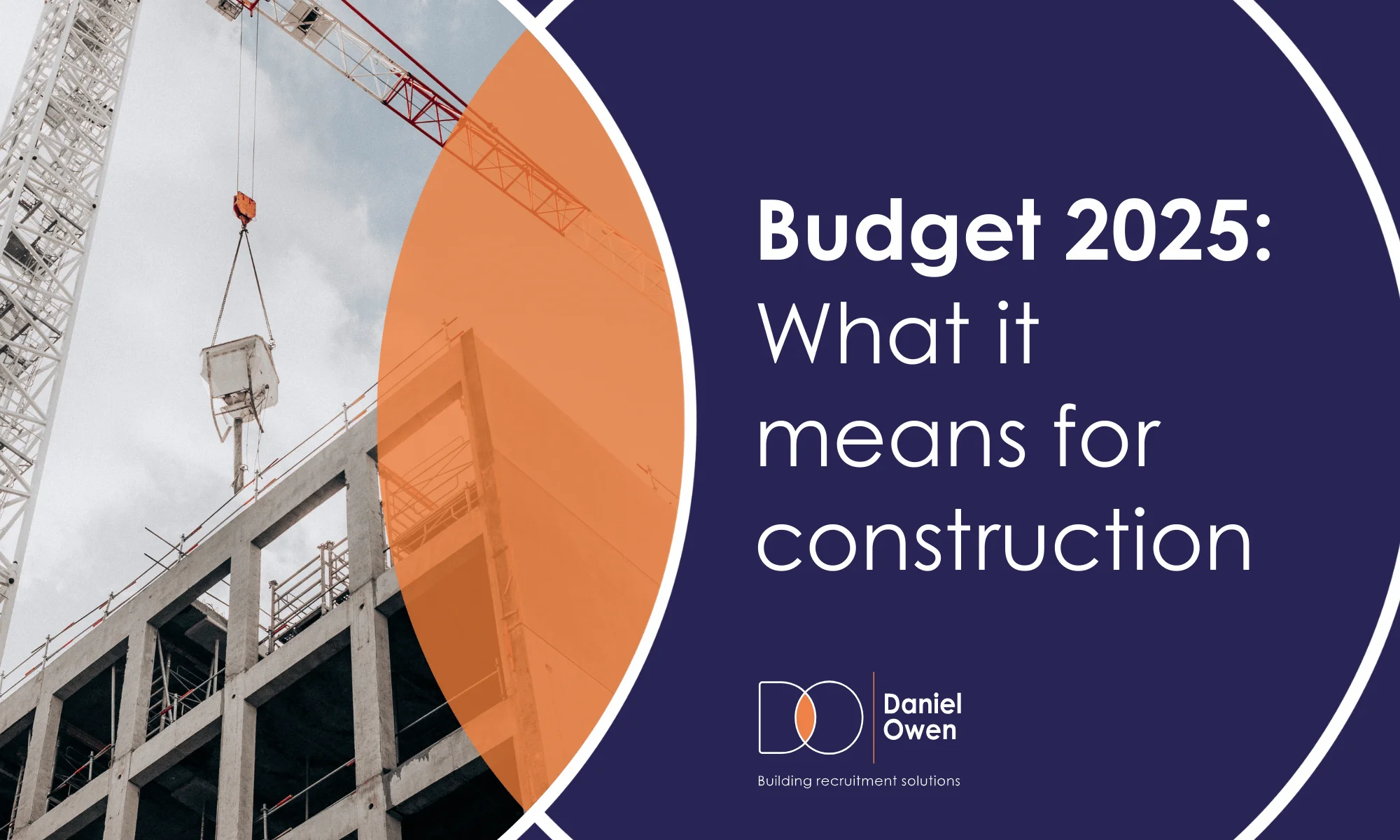
How the 2025 Autumn Budget Affects the Construction Industry
27 Nov, 20257 MinutesTL;DR:The 2025 Autumn Budget introduces significant payroll cost increases (£1,200-£1,500/ye...

TL;DR:
The 2025 Autumn Budget introduces significant payroll cost increases (£1,200-£1,500/year per employee), a mansion tax that will slow high-value development, and a new drive for planning reforms and sustainability. Employers must act immediately to adjust compensation and hiring focus, and to respond to property tax changes. Candidates will find rising demand in project management, sustainability, and specialist roles.
The November UK Budget marks a pivotal moment for the UK construction sector, introducing changes that will reverberate through every level of the built environment. Whether you're a construction employer planning your next projects or a skilled candidate weighing job opportunities, understanding the Budget's impact is essential for navigating the year ahead.
1. Immediate Tax and Cost Impacts
1.1 Rising Payroll Costs: Employer National Insurance & Minimum Wage
From April 2026, construction employers will face additional annual payroll costs of approximately £1,200-£1,500 per employee due to the employer National Insurance threshold freeze and the minimum wage increase to £12.71/hour. These changes could force hiring freezes or margin compression for many firms.
According to the Office for Budget Responsibility and CIF surveys (Nov 2025), 89% of construction businesses are concerned about these escalating costs affecting their ability to hire and retain workers. Retention strategies and targeted upskilling may become a lifeline as the sector faces record recruitment challenges.
If you are reviewing your headcount plans or need to replace key staff without increasing risk, speak to the Daniel Owen team about building a resilient workforce plan for 2026 and beyond.
1.2 Mansion Tax & Property Levies
From April 2028, new annual levies (£2,500–£7,500) will apply to properties valued above £2 million, with additional council tax surcharges and possible stamp duty increases. This is expected to reduce high-value residential project starts in London and the South East.
Industry analysts project a slowdown in new project launches and a more cautious outlook among developers and investors. Firms that focus on prime development or luxury refurbishments should expect a thinner pipeline through 2029.
1.3 Other Tax & Compliance Pressures
Changes to salary sacrifice arrangements, anticipated reforms to business rates, and property taxation for landlords mean construction businesses must scrutinise all payroll and investment structures. Rental yields may fall for landlords, and contractors specialising in BTR or PRS sectors should monitor evolving tax guidance.
2. Labour Market & Skills Implications
2.1 Skills Shortage Intensifies: Supply-Demand Dynamics
The government's 1.5 million homes target by 2029 requires 61,000 extra workers annually (a 12% workforce increase), but declining business confidence and rising employment costs threaten investment in training.
Employers competing for critical roles-such as project managers, sustainability engineers, planners, and net zero retrofit specialists-will need stronger salary offers, rapid onboarding, and a clear brand value proposition. Apprenticeships and partnerships with training providers may safeguard medium-term workforce pipelines.
2.2 Wage Growth & Retention Pressures
Those working in construction, particularly those with green skills, digital project delivery experience (e.g., BIM specialists), and high-level certifications, will see above-inflation wage growth and more flexible employment opportunities. As employer competition intensifies, expect frequent counteroffers, remote and hybrid work incentives for non-trade roles, and broader benefits.
If you are considering commercial or project-side career paths, roles like Quantity Surveyor offer strong long-term prospects and clear progression routes in this environment.
Explore what a Quantity Surveyor does, the skills required, and typical salaries in our guide >>
3. Planning Reform & Opportunity Zones
3.1 Streamlined Approvals: New Town and Brownfield Projects
The Budget pledges more streamlined, "default yes" approvals for major projects around transport hubs, at least three new towns, extra planner funding, and brownfield-first priorities.
If implemented, these reforms could lead to new job creation and consistent project pipelines, reversing the current trend of project delays and cancellations. Early-career professionals and established candidates in planning, design, engineering, and delivery will be in high demand.
If you want a clearer picture of how these roles fit together across the wider built environment, our ‘Understanding the Built Environment’ guide breaks down the key sectors, job types, and career paths.
3.2 Timeline & Project Pipeline Growth
The impact of planning reform is expected in stages:
- Short-term (Dec 2025-March 2026): Policy groundwork and planning department recruitment.
- Medium-term (Spring 2026-end 2027): Surge in permissions for transport-linked and brownfield housing.
- Long-term (2027-2029): New town construction, major infrastructure launches.
4. Sustainability and Innovation
Net zero commitments will trigger new grants, retrofit programmes, and incentives for sustainable building practices. Firms leading in modern methods of construction and green capabilities will see the strongest growth and most robust hiring needs.
The government is reinforcing its net-zero commitments, with more substantial incentives around energy-efficient construction, retrofitting, and sustainable materials. Watch for upcoming grants, enhanced allowances, and reliefs that could make green building projects - and related skills - more attractive to both employers and candidates. Firms positioned at the forefront of sustainable construction or digital transformation will benefit most from new investment and regulatory focus.
Whether you are an employer scaling your sustainability teams or a candidate looking to move into green, retrofit, or digital roles, Daniel Owen can help you align with the strongest parts of the market.
Employers can outline upcoming hiring needs here >>
Looking for work? Search here >>
5. What This Means, Immediate Actions
For Employers
- Review compensation - Budget for payroll cost increases and modernise retention strategies (e.g., bonus structures, L&D offers).
- Strategic hiring focus - Prioritise recruitment in project leadership, digital construction, net zero, and planning.
- Prepare for property and tax reforms - Audit project pipelines and pricing for new levies and regulatory changes.
- Invest in training and technology - Secure apprenticeships and adopt digital tools to boost productivity.
If you are rebalancing your team structure, consolidating suppliers, or planning new project teams for 2026–2029, Daniel Owen can help you secure the specialist talent you need while the market is shifting.
For Workers
- Upskill for green and digital roles - Focus on retrofit, sustainability, and BIM project management.
- Monitor market shifts - Stay agile to take advantage of wage growth opportunities in high-demand roles.
- Engage with specialist recruiters - They will have early access to pipeline and project opportunities arising from budget-driven investment.
Contact your specialist local recruitment team >>
6. Summary Table: Budget 2025 – Construction Impact
Impact Area | Change | Effective Date | Estimated Cost/Impact | Who's Affected |
Payroll Costs | NI threshold freeze + £12.71/hr min wage | Apr 2026 | +£1,200–£1,500/employee/yr | Employers |
Mansion Tax | £2.5k–£7.5k annual on >£2m homes | Apr 2028 | Sustained decline in £2m+ homes | Developers, prime residential |
EV Road Tax | Mileage-based charge | Apr 2028 | +£1.4bn/yr (nationally) | Logistics, plant hire, contractors |
Planning Reform | Streamlined, brownfield-first | Dec 2025+ | +£13bn housing investment | Planners, contractors, consultants |
Sustainability | Net zero retrofit support | 2026 onwards | £2–3bn sector funding | Retrofit specialists, green skills roles |
Frequently Asked Questions: Budget 2025 & Construction
Q: How will the 2025 Budget affect my construction payroll costs?
A: Employers face an additional £1,200–£1,500 per employee annually due to payroll tax and minimum wage changes from April 2026.
Q: Will the mansion tax slow housing delivery?
A: Yes, high-end residential developments will see a sustained decline, affecting developers and project suppliers.
Q: What roles will be in highest demand post-budget?
A: Planning specialists, green retrofit professionals, BIM managers, and project leaders.
Q: Will my wages increase in 2026 if I'm an apprentice or early-career tradesperson?
A: Yes, significantly. From April 2026, the apprentice minimum wage rises to £8/hour (a 6% increase), and the 18–20 minimum wage jumps to £10.85/hour (an 8.5% increase). However, experienced tradespeople will see even stronger wage growth. Skilled trades such as bricklayers, plumbers, electricians, and carpenters are forecast to see 4-6% pay increases, with top performers commanding 5–8% or more.
Q: Which trades will have the best job security and wage growth post-budget?
A: Carpenters, electricians, plumbers, and welders are most in demand, though welders face particular shortages (10% decline in workforce). Net-zero retrofit specialists, ground workers, and stonemasons are also critical to new infrastructure. Demand for these roles is expected to remain strong through 2028–2029.
Q: Should I invest in green skills training?
A: Absolutely. The sector needs 230,000+ retrofit workers by 2030, and training in heat pump installation, solar panels, and EV chargers can command premium rates (often 15–25% above standard wages). Green skills are among the fastest-growing and best-paid specialisms.
Q: Will the minimum wage rise affect self-employed tradespeople?
A: Indirectly. Higher living costs mean your competitors and employees will earn more, but self-employed rates often rise 4-6% annually regardless. Focus on building reliability and reputation; top performers consistently command 5-8% annual increases in competitive markets.
Conclusion
The 2025 Autumn Budget ushers in a challenging landscape for the construction industry: Higher costs and tax uncertainty on one hand, ambitious planning reform and sustainability investment on the other. The most successful employers and candidates will be those who adapt swiftly, invest in skills, focus on innovation, and seize opportunities in the rapidly evolving built environment.
If you want a specialist partner to help you do that, Daniel Owen works exclusively across the built environment, supporting both organisations and workers through changing market conditions.



